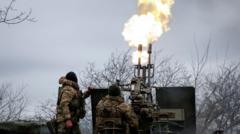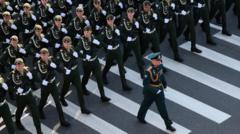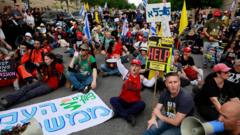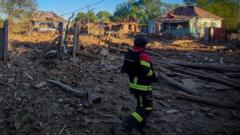In the backdrop of ongoing conflict, the sincerity of Putin's unilateral Easter truce in Ukraine is being questioned, stirring debate over diplomatic intentions.
**Rosenberg: Putin's Easter Truce – A Genuine Gesture or Political Posturing?**

**Rosenberg: Putin's Easter Truce – A Genuine Gesture or Political Posturing?**
As Russia declares a brief ceasefire, questions arise about its motives and the potential for peace.
In a surprising announcement, Russian President Vladimir Putin declared a unilateral truce in Ukraine coinciding with the Easter holiday, effective until midnight Sunday. This ceasefire, described by the Kremlin as humanitarian, comes amid escalating violence on the ground and only after significant international diplomatic engagement.
While Ukraine has shown skepticism toward this temporary pause, seeing it as a strategy to create an illusion of peace, Russia insists its forces are adhering to the ceasefire framework. Ukrainian President Volodymyr Zelensky countered by highlighting ongoing military actions by Russia despite the declared truce, painting a grim picture of the situation.
The timing of this truce is crucial. It arrives after recent proposals from the Trump administration for a comprehensive ceasefire, which Ukraine had accepted but Russia complicated with a heavy list of conditions. Instead of a substantive agreement, Putin’s 30-hour ceasefire appears to be more of a public relations move intended to cast Russia as a peacemaker in the eyes of international observers.
Moreover, as Putin seeks to improve relations with the Trump administration, there are indications that American patience is thinning with the lack of progress in resolving the conflict. Trump has made it clear that failure to advance peace talks may lead the U.S. to withdraw from negotiations entirely. By declaring a ceasefire, the Kremlin may hope to deflect blame for ongoing hostilities onto Ukraine and assert itself as the party open to negotiations.
Conversely, there are those who see the truce as a potential opening for meaningful diplomacy. The recent frequency of high-level meetings involving U.S. and Russian officials offers a glimmer of hope. Envoy Steve Witkoff's engagements with Putin and the discussions in Paris involving U.S. and Ukrainian representatives suggest that some groundwork for a genuine peace process may be quietly underway.
While it remains to be seen whether this brief pause in hostilities can transform into a more sustainable peace agreement, the atmosphere surrounding the truce is fraught with uncertainty. Ultimately, the situation is fluid, and the international community will be watching closely to see if ulterior motives cloud the possibility for a genuine cessation of fighting.
While Ukraine has shown skepticism toward this temporary pause, seeing it as a strategy to create an illusion of peace, Russia insists its forces are adhering to the ceasefire framework. Ukrainian President Volodymyr Zelensky countered by highlighting ongoing military actions by Russia despite the declared truce, painting a grim picture of the situation.
The timing of this truce is crucial. It arrives after recent proposals from the Trump administration for a comprehensive ceasefire, which Ukraine had accepted but Russia complicated with a heavy list of conditions. Instead of a substantive agreement, Putin’s 30-hour ceasefire appears to be more of a public relations move intended to cast Russia as a peacemaker in the eyes of international observers.
Moreover, as Putin seeks to improve relations with the Trump administration, there are indications that American patience is thinning with the lack of progress in resolving the conflict. Trump has made it clear that failure to advance peace talks may lead the U.S. to withdraw from negotiations entirely. By declaring a ceasefire, the Kremlin may hope to deflect blame for ongoing hostilities onto Ukraine and assert itself as the party open to negotiations.
Conversely, there are those who see the truce as a potential opening for meaningful diplomacy. The recent frequency of high-level meetings involving U.S. and Russian officials offers a glimmer of hope. Envoy Steve Witkoff's engagements with Putin and the discussions in Paris involving U.S. and Ukrainian representatives suggest that some groundwork for a genuine peace process may be quietly underway.
While it remains to be seen whether this brief pause in hostilities can transform into a more sustainable peace agreement, the atmosphere surrounding the truce is fraught with uncertainty. Ultimately, the situation is fluid, and the international community will be watching closely to see if ulterior motives cloud the possibility for a genuine cessation of fighting.




















